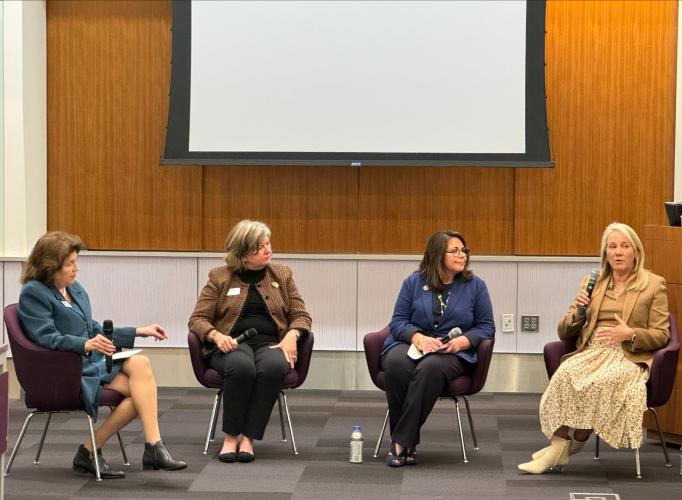
At the Smithsonian American Women’s History Museum, our mission is to share the often-untold accounts and accomplishments of women and to inspire conversation, connection, and change. Co-creation and community engagement is vital to the success of our mission, so we work to connect with communities across the nation and amplify the work that is already happening to revise historical inaccuracies and surface new and under-appreciated stories. The Women Making History Network is our nationwide volunteer program. Network members strengthen our presence regionally, help us connect with volunteer leaders more effectively nationally, inspire philanthropic support, and host events that showcase our work in their communities.
On March 6, 2024, we invited representatives from our three active regions, Colleen Ochoa Peters (MI), Bridget Bush (KY), and Alice Jacobs (NY), to speak to our advisory council meeting and share the strategies, goals, and successes from their regions. Below are the remarks from Alice Jacobs, co-chair of the Western New York Women Making History Committee, highlighting strategies for community engagement and the impact an inspired community can have.
The Western New York Women Making History Committee (WNYWMHC) began out of a conversation between myself and New York State Senate Majority Leader Crystal Peoples-Stokes. Crystal has been a passionate supporter of the Western New York (WNY) community, always working to steward change that engages and impacts a broad range of people. She knows both intuitively and through the results she has seen that creating true impact and change requires broad and inclusive engagement. Crystal has now brought this same passion to the formation of the Smithsonian American Women’s History Museum.
Watching Crystal work and accomplish a great many things over the years inspired my view of leading community change as well. While leading the board in the transformation of the Albright-Knox Art Gallery to the Buffalo AKG Art Museum, I took Crystal’s example and intentionally (and authentically) shaped the narrative that the AKG Art museum needed to evolve and become a vibrant resource for our entire community so that it would be sustainable well into the future.
Someone recently said to me “Buffalonians feel like it is their museum now,” and this made my heart sing. Our core belief was that it takes everyone to get involved and feel like they are part of the museum in order to get it done. We asked people what they wanted to see in the museum and to support at any level—from $20 to $62 million. Our process was to reach out to every corner of the city and beyond because we believed that is how you foster real change.
So how do you take this lens of inclusivity to a museum with a physical presence in our nation’s capital, working to represent the entire country and share untold stories? To achieve its mission of not only “creating a space for women’s history on the national mall,” but through that “inspiring conversation, connection and change,” the museum needs to belong to women (and men) throughout our country.
To foster the feeling of community ownership, people need to see a Smithsonian institution as more than a place that you might visit on a high school trip to DC. It needs to be seen as a community resource and source of energy, inspiration, and connectivity. However, the community is not Buffalo, it is the nation. Just the thought of such a place, dedicated to sharing and building on the history of our foremothers, is inspiring to me as a philanthropist and a museum advocate.
Getting there is a new road. Crystal knew that she wanted this museum to engage with and matter to women in WNY. As we talked about how to accomplish this, I realized that in my experience, there is no better route to engagement than knowing that you helped create something. Thus, the WNYWMH committee was established with the twin goals of spreading the word and creating excitement about the establishment of the museum and raising funds from WNY to support the endeavor.
After our first annual event, the committee found itself with a third goal: being a connector of women in our community. While there are various women’s professional networks and social groups in our area, in the experience of our committee members, we found the ability to create connections across divides unique to this event. How did this come to be? We created the committee with a specific matrix around age, personal and professional interests, geography, and race. The committee then assembled the invitation list from their networks. When all 350 women assembled at the Westin Hotel on a cold January night—and Buffalo January’s are COLD, the rumors are true—we realized we had an incredibly accomplished and diverse group. Truthfully, the comradery and friendship shared in the room that night was an emotional experience for all of us.
Part of the special feeling that created the electricity in the room that cold night, was that we had all come together for a bigger purpose than ourselves—one bigger than even our mothers and daughters and families or our Buffalo community. We were coming together for the women of our nation, connecting with each other in order to connect with all of the other women like us around the country, before us, and yet to be. It was an inspiring evening and an even more inspiring mission.
Alice Jacobs, Co-chair
Innovation Philanthropist & Strategist
Western New York Women Making History Network